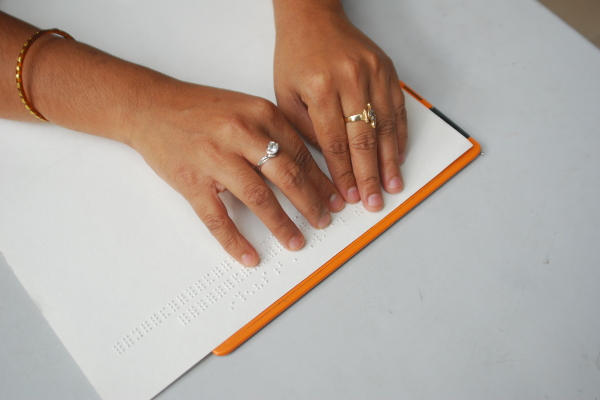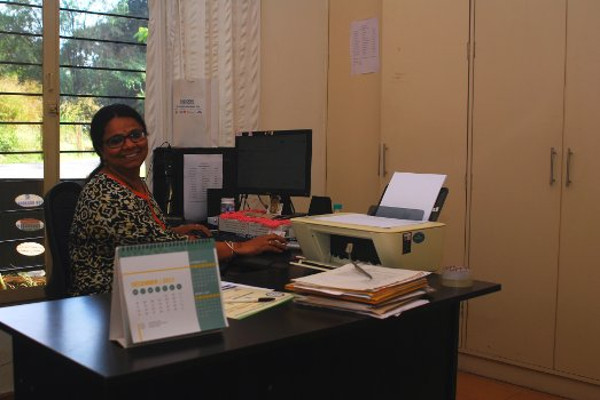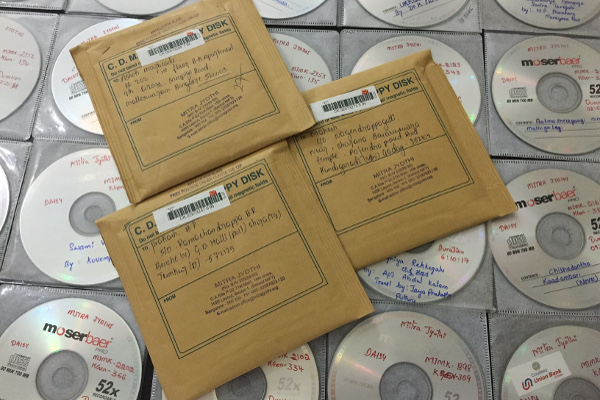

Education Resource Centre
Mitra Jyothi’s Education Resource Center provides a varied collection of accessible text & reference books, magazines, fiction & non-fiction books in multiple languages and formats with the primary objective of providing reading material to those who cannot read printed matter with the help of their vision. The “Digital Accessible Books Production” (DABP), “Talking Book Library” (TBL) and “Braille Transcription Centre” (BTC) are the Programs that cater to these requirements. With this, the need of both a young school child who will find Braille books more useful and adults who may switch to audio libraries and text to speech conversion technology for faster and more efficient reading, is addressed.
Hundreds of volunteers lend their time and voice and record books for us. Keeping up with technology trends, Mitra Jyothi has digitized a significant portion of the TBL. With newer and newer technology available for text to speech conversion and the remarkable improvement in the quality of audio output, Mitra Jyothi constantly works on process improvements and necessary trend adaptations.
Most of these books are getting uploaded in Bookshare, Sugamya Pustakalaya to make it available online for a vaster group across pan India.
Call us or register online by clicking here to enrol to the library membership!
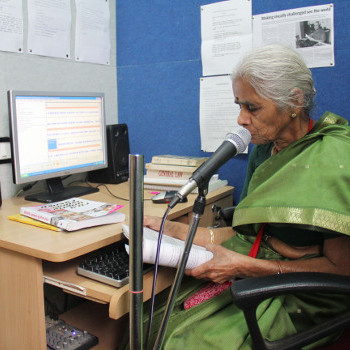
 eText: eText version of any book will make it readable by using any screen reading software like NVDA (Non Visual Desktop Access)
eText: eText version of any book will make it readable by using any screen reading software like NVDA (Non Visual Desktop Access) DAISY (Digital Accessible Information System): DAISY is a digital audio format. It designed to be a complete audio substitute for print material and is specifically designed for use by people with visual disabilities and dyslexia.
DAISY (Digital Accessible Information System): DAISY is a digital audio format. It designed to be a complete audio substitute for print material and is specifically designed for use by people with visual disabilities and dyslexia. Braille: Hard copy prints in Braille
Braille: Hard copy prints in Braille
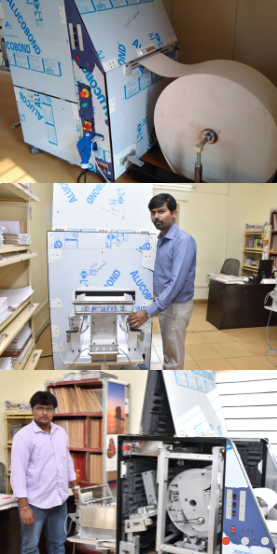 Braille Printing
We print in Braille in English and other Indian languages. Lakhs of pages have been printed since the commission of our Braille Transcription Centre in late 2015. Printing & distributing school text books in Braille and creating Braille book libraries in schools has been the key contribution of Mitra Jyothi’s Braille Transcription Centre. Braille books are especially helpful to school students, who are either visually impaired or have low vision. Mitra Jyothi has taken up the big project of printing text books in Braille for students of class 1 through class 10 (Karnataka State syllabus) for both English and Kannada medium. Providing text books in Braille free of cost to 40+ schools/institutions for the blind across Karnataka has been our flag-ship project since 2017!
Along with text books, books of various kinds including but not limited to fiction, non-fiction, inspiration life stories, cookery, sports, leaders, health & hygiene, legal rights and other topics are being transcribed into Braille in Kannada and English for children of all age groups. These books shall be used to build Braille Libraries across the various schools for the blind in the state of Karnataka.
Tactile Embossing
The Braille Transcription Centre also has a tactile embosser that can print pictures and diagrams in tactile. Tactile Pictures are images that use raised surfaces so that a visually impaired person can feel them. They are used as teaching aids to help children with visual disability learn about the form of various objects from fruits, vegetables, basic objects, and animals to more complex maps, scientific diagrams and paintings.
If used effectively Tactile Embossing is a very useful tool and will be a game changer in the lives of people with vision impairment.
It opens up the world of Science and Math education for the visually disabled. Right now other than basic concepts in primary school, the visually disabled are deprived of science and math education due to limitations of comprehension of diagrams, figures and graphs which are an essential part of math and science education.
Tactile diagrams can be used as teaching aids to help children with visual disability learn about the form of various objects from fruits, vegetables, basic objects, animals to more complex maps and paintings.
Tactile diagrams help teachers who are visually impaired to conceptualize and teach more effectively
Tactile printing in colour a big boon to people with low vision
Braille Printing
We print in Braille in English and other Indian languages. Lakhs of pages have been printed since the commission of our Braille Transcription Centre in late 2015. Printing & distributing school text books in Braille and creating Braille book libraries in schools has been the key contribution of Mitra Jyothi’s Braille Transcription Centre. Braille books are especially helpful to school students, who are either visually impaired or have low vision. Mitra Jyothi has taken up the big project of printing text books in Braille for students of class 1 through class 10 (Karnataka State syllabus) for both English and Kannada medium. Providing text books in Braille free of cost to 40+ schools/institutions for the blind across Karnataka has been our flag-ship project since 2017!
Along with text books, books of various kinds including but not limited to fiction, non-fiction, inspiration life stories, cookery, sports, leaders, health & hygiene, legal rights and other topics are being transcribed into Braille in Kannada and English for children of all age groups. These books shall be used to build Braille Libraries across the various schools for the blind in the state of Karnataka.
Tactile Embossing
The Braille Transcription Centre also has a tactile embosser that can print pictures and diagrams in tactile. Tactile Pictures are images that use raised surfaces so that a visually impaired person can feel them. They are used as teaching aids to help children with visual disability learn about the form of various objects from fruits, vegetables, basic objects, and animals to more complex maps, scientific diagrams and paintings.
If used effectively Tactile Embossing is a very useful tool and will be a game changer in the lives of people with vision impairment.
It opens up the world of Science and Math education for the visually disabled. Right now other than basic concepts in primary school, the visually disabled are deprived of science and math education due to limitations of comprehension of diagrams, figures and graphs which are an essential part of math and science education.
Tactile diagrams can be used as teaching aids to help children with visual disability learn about the form of various objects from fruits, vegetables, basic objects, animals to more complex maps and paintings.
Tactile diagrams help teachers who are visually impaired to conceptualize and teach more effectively
Tactile printing in colour a big boon to people with low vision
 Visiting Card Embossing
The Braille Transcription Centre also has a visiting card embosser. Braille embossing done on visiting cards make them accessible to the visually impaired. We undertake visiting card embossing work for individuals and organizations. Call us to make your visiting cards accessible to all!
Visiting Card Embossing
The Braille Transcription Centre also has a visiting card embosser. Braille embossing done on visiting cards make them accessible to the visually impaired. We undertake visiting card embossing work for individuals and organizations. Call us to make your visiting cards accessible to all!
- It opens up the world of Science and Math education for the visually disabled. Right now other than basic concepts in primary school, the visually disabled are deprived of science and math education due to limitations of comprehension of diagrams, figures and graphs which are an essential part of math and science education.
- Tactile diagrams can be used as teaching aids to help children with visual disability learn about the form of various objects from fruits, vegetables, basic objects, animals to more complex maps and paintings.
- Tactile diagrams help teachers who are visually impaired to conceptualize and teach more effectively
- Tactile printing in colour a big boon to people with low vision
